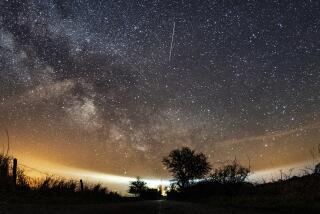MAKING A DIFFERENCE : One Observatory’s Approach: ‘Star Parties’ for Everyday People
- Share via
More than 1.8 million people each year relieve their earthbound routine with a visit to Los Angeles’ Griffith Observatory. A handful of scientists, trained guides and volunteers ensure that thousands who aren’t likely to get to the observatory still have a chance to see something of the heavens from their own neighborhoods. For more than 50 years Griffth Observatory astronomers and trained guides have been bringing portable telescopes to schools, libraries, parks and recreational centers to introduce stargazing to people throughout Los Angeles. With volunteers from local astronomy clubs supplementing the observatory’s outreach efforts more than 20,000 people in Los Angeles and Orange counties look through traveling telescopes each year. Scores of people gather outdoors for “star parties” around the region to peer through telescopes while guides direct them to objects in the sky. But those who offer their equipment and expertise to provide access to sights millions of miles away sometimes pay a price. Recently, nearly $3,000 in telescope accessories collected for more than 20 years was stolen from one volunteer while he helped conduct a star party near a downtown Los Angeles library branch.
WHY LOOK TO THE SKIES?
Anthony Cook
Griffith Observatory’s Astronomical Observer
All of us can learn about a different way of looking at where we are in the universe when we look into the sky. We can learn how we’re connected by seeing what makes it real that we’re all a part of the Milky Way.
The traveling telescope removes astronomy and the study of the universe from being an academic and remote topic. We show people the excitement in the images of astronomy by presenting them directly.
I don’t want to sound hackneyed about encouraging a sense of wonder about the skies, but often our immediate environment in the city can be depressing. We forget or don’t realize that we’re surrounded by incredible things that we can experience with our own eyes, like constellations and most of the planets.
The traveling telescope is not only for children, but for everyone and especially for those who can’t make it up to the observatory--seniors and those who might not have transportation to visit us. I’ve seen people who speak all different languages, who come from different cultural backgrounds and I’ve seen homeless people get into serious discussions about the sky. Seeing the moon’s surface, the rings of Saturn removes believing in their existence from being dependent upon someone else’s authority. You can verify it and test that truth yourself. We try to make that science real, to animate its process and to remove it from the idea that it’s abstract drudgery.
ONE NIGHT OF SIGHTS FROM THE SIDEWALK
On cloudless nights with a little astronomical knowledge and no more than a pair of binoculars Southern Californians can spot plenty in the sky even through an atmosphere fouled by urban light and smog.
This year the Griffith Observatory will celebrate Astronomy day April 16 from 1:30 p.m. to 10 p.m. Observatory guides will conduct special telescope tours; astronomy clubs will set up additional telescopes on the observatory lawn for guests to look through. With binoculars, sidewalk astronomers throughout Southern California can spot:
Craters on the moon, 238,000 miles from Earth
Phases of Venus, 144 million miles from Earth
Moons of Jupiter, 414 million miles from Earth
Orion Nebula, gaseous star cloud 1,600 light years from Earth
Comet McNaught-Russell, 84 million miles from Earth
TO GET INVOLVED
For information about donations and volunteer opportunities at the Los Angeles Observatory, call Friends of the Observatory, (310) 559-9707. For information about traveling telescope availability, call Anthony Cook at (213) 664-1181. Program requests must be made in writing and must be scheduled at least five weeks in advance. Write Traveling Telescope, Griffith Observatory, 2800 E. Observatory Road, Los Angeles, CA 90027.
L.A. Sidewalk Astronomers, a public service astronomical organization, conducts star parties, astronomy slide shows and telescope-making workshops. Call Bill Scott at the Vedanta Society for information, (213) 465-7114.
One of the country’s largest local astronomy clubs, Orange County Astronomers, provides extensive benefits--including observation site, telescope and library access--to its members and services--including star parties--to community groups. For community outreach information, call Joel K. Harris, (818) 841-8245. For membership information, call Charlie Oostdyk, (714) 751-5381.
More to Read
Sign up for The Wild
We’ll help you find the best places to hike, bike and run, as well as the perfect silent spots for meditation and yoga.
You may occasionally receive promotional content from the Los Angeles Times.






